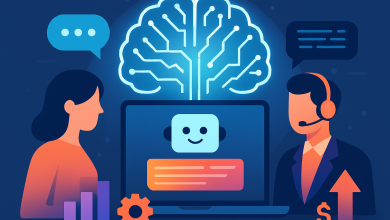
As artificial intelligence (AI) enthusiasm sweeps boardrooms, a dangerous pattern has emerged: companies eager to embrace AI push their organizations to do so, only to discover that positive attitudes alone don’t deliver results. The harsh reality is that organizational AI readiness exists on three critical levels: your company’s operating foundation, efficiencies to enhance said foundation, and the layers above your foundation that create the ability to drive competitive innovation.
The prevalence of AI in today’s industries seems to be happening at lightspeed. As an example, according to the 2025 AI Index Report from Stanford University, “In 2023, the FDA approved 223 AI-enabled medical devices, up from just six in 2015.” Furthermore, the same report claimed “78% of organizations reported using AI in 2024, up from 55% the year before.” All this paints a picture of huge growth!
While executive enthusiasm and workforce openness represent a basic cultural necessity to enact meaningful change, they become meaningless without the supporting organizational structures and data infrastructure required for successful implementation. This means that those from the top of the organization are not doing the proper legwork to advocate for, and explain “the why” behind AI adoption among employees in the workforce. As such, AI is being added to the operational structure as a check-the-box item rather than a solution to empower competitive advantage in the marketplace. Without the right adoption process and approach, AI runs the risk of actually slowing down your business rather than accelerating it.
How do you build true organizational AI readiness beyond the boardroom?
Explain Why AI is Important to the Future of Your Business
Once your boardroom is aligned on wanting to start incorporating more AI into your business, it’s time to start building advocacy for it within the rest of your organization. Provide tangible examples for why having AI integrated into your systems—at the very foundation of your business—will aid employees in reaching their quarterly goals and act as a tool to help them operate faster as a team. Keep the message directly tied to their personal benefits, why they should care, and how it will help their career growth. Then expand the message to why the AI integration will help their specific departments, and how it will allow for faster cornering in the marketplace to tackle uncertainties that competition throws your direction.
This stage of the process is all about buy-in. While most of the buy-in convincing usually flows from the bottom-up in an organization, AI is the unique circumstance where it flows in the opposite direction. This is because many employees are fearful of what AI will do to their job security and viability, since unfortunately much of what they see in the news today mentions how AI will upend the workforce as they know it.
Ask yourself, why are you so excited about AI? If you can’t answer this question with a tangible reason for your workforce, then you’re not ready for it. Adopting AI just to “keep up with the rest” will no doubt put your business into the same bucket as “the rest.”
Start with Enhancing Your Systems’ Foundation
According to this report from McKinsey, “Companies with at least $500 million in annual revenue are changing more quickly than smaller organizations.” This is perhaps because the larger the organization, the more budget they have available to go around making their AI implementations work. In contrast, smaller businesses have limited budgets and very little room for error when it comes to new implementations. Budget translates to resources, and AI demands a lot of resources upfront to be successful.
Just as with building a house, you want to start with the foundation. As your business already has a foundation (vision & mission, employee culture, core technology tools, cloud systems, etc.), the process will be about examining areas where cracks have started to form in the foundation, using AI first as a tool to mend those cracks and strengthen how the whole business operates. It will showcase to your organization some early wins that will come in handy for making larger changes later.
Priming your organization for AI readiness will facilitate the data readiness of system changes. For example, if your organization is data-rich but those datasets are housed in disparate systems that can’t communicate with each other, then you are not utilizing the full potential of those datasets. If this is the case for your organization, think about how you can synthesize your data warehousing into one repository, or a couple of repositories that can communicate with each other, to ensure that there remains one source of truth for your organization when performing data analysis.
What I found most interesting about the McKinsey report I mentioned earlier is this: “28% of respondents whose organizations use AI report that their CEO is responsible for overseeing AI governance, though the share is smaller at larger organizations with $500 million or more in annual revenues, and 17% say AI governance is overseen by their board of directors.” This tells me that, in contrast, most businesses do not have their CEO and board at the helm of their AI governance. To me, this speaks volumes in terms of what companies are seeing as necessary to be successful: when you let the employees lead the innovation, you have broader buy-in for some of the more radical transformations that must occur.
If your executive leadership is uneasy with handing over the keys to AI innovation to your workforce completely, try forming a small task force with different representatives from each department. Put the onus on them to strategize and execute the AI implementation, ensuring all parties have a say along the way. Plus, it will allow you to keep an eye on progress in a small group setting rather than in a large-scale hop-around.
Structure Your Data for Ease of Use and Acceleration
Most of the hotness around AI is hidden behind the scenes. It’s all about the data engineering and the structuring of the data to contribute business value. Without those things being in place, your AI projects are going to fail and probably fail miserably. Too often, business leaders forget about all the integrations and the data, data sourcing, data mapping, and data consolidation that go into implementing AI effectively. And then there’s data cleansing too, which can be immensely time-consuming if you must do it manually. All these things are hidden.
Companies need to be a little bit realistic when it comes to AI usage—there’s not an easy button that’s going to cure all their problems. A lot of the traditional models of business—and business tools—still need to be present, at least for the time being, to double check that AI systems are spitting out accurate information and analysis.
In fact, for some businesses, incorporating AI into operations may be more of a hassle than good for the time being, at least until the AI technology matures enough to solve their more complex data challenges. Companies are always going to try to innovate, to reduce costs in the long run and automate whatever they can with AI, and while this is a good thing, AI technology is also expected to rapidly innovate and change, which means the basic blocking and tackling still stays the same.
The Quality of Your Data Comes First
In truth, you can’t make informed decisions for the agility of your business without knowing that the information is reliable. This is why having the correct infrastructure to retain and analyze your datasets is key, and maintaining the quality of data that you need to make the right decisions is paramount—you don’t want skewed information.
Implementing AI can, at times, feel like you are a doctor treating symptoms rather than the underlying cause. It’s crucial to get to the underlying cause if your AI adoption is going to meaningfully contribute a return on investment (ROI). Many organizations have all this data constantly accumulating, but they don’t know what to do with it. How to reap the full benefits and insights from what the data is telling them. If they have engineers, and the datasets are particular and tedious to analyze, those engineers are doing what they’re supposed to do—to build out AI on top of that is a big deal.
Your business may have a huge data problem that must be tackled first, before you can even think about adding AI to the equation in any meaningful way. Because of this, it could even mean that by the time you have got all your datasets cleaned up, the AI you would have implemented has become outdated. As such, it’s best to wait until you have the first steps of your process completed before you begin any AI implementations, to be sure you have selected the latest, best version for your business. Dialogue with all stakeholders, as always, is crucial to ensure business success, not just for the short term but for the long term.





